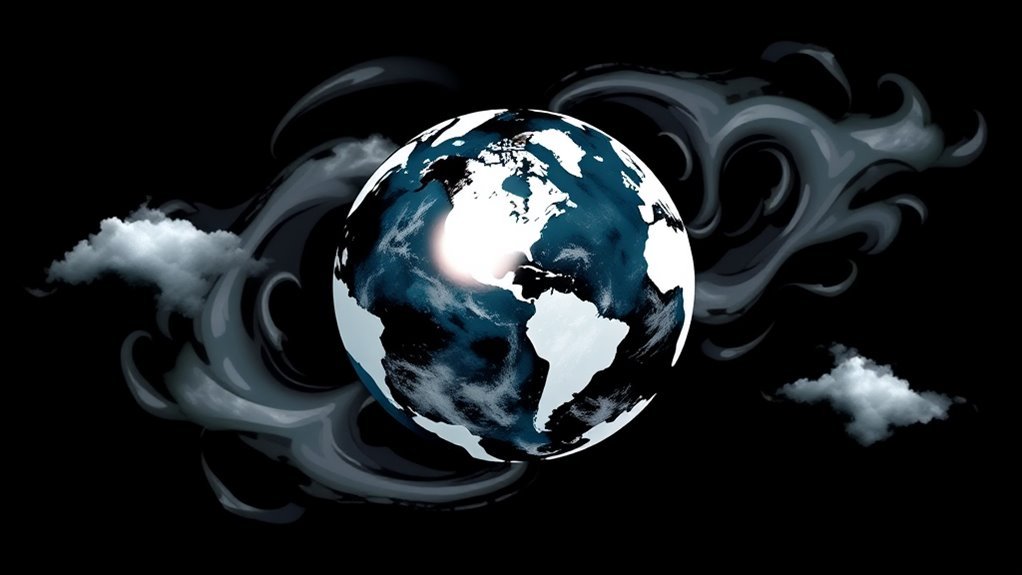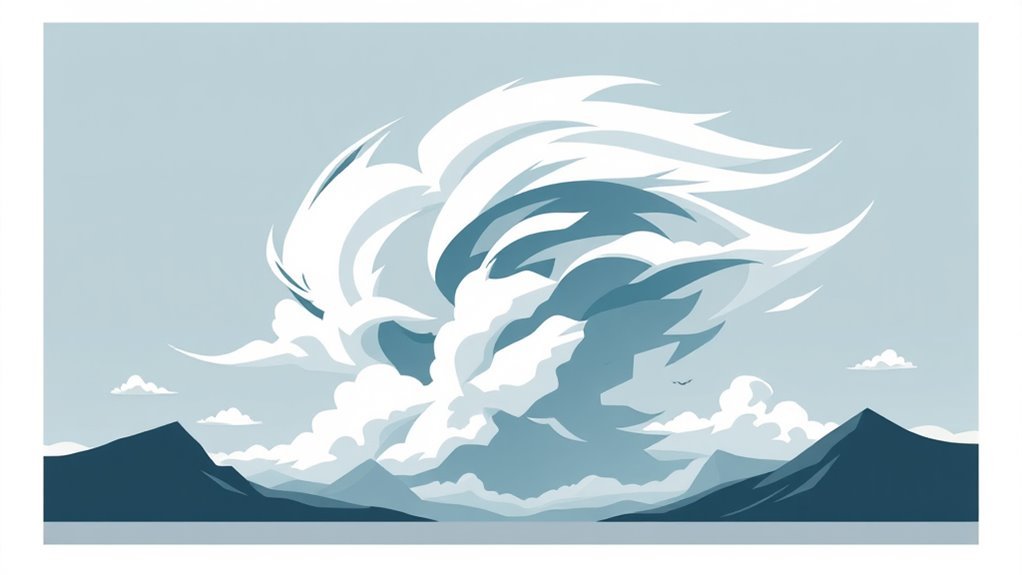Changes in wind circulation patterns greatly influence squall formation worldwide. Variations in temperature and pressure alter airflow, affecting how air masses interact. This can lead to stronger squalls in coastal regions or areas near large bodies of water. Additionally, shifts in global climate patterns, such as El Niño, can disrupt traditional wind dynamics, enhancing squall activity. These complex interactions reveal crucial understandings about environmental processes awaiting exploration.
Main Points
- Changes in global wind circulation patterns can lead to increased squall frequency and intensity in certain regions due to enhanced air mass interactions.
- Alterations in temperature and pressure systems from climate change can disrupt traditional squall formation processes, resulting in unpredictable weather events.
- The influence of phenomena like El Niño significantly modifies wind patterns, affecting localized squall development and precipitation distribution worldwide.
- Urbanization impacts wind dynamics, creating heat islands that can intensify squall effects by altering local circulation patterns.
- Shifts in ocean currents due to changing wind patterns can affect humidity levels, further influencing the formation and severity of squalls.
The Basics of Wind Circulation and Squall Formation
Wind circulation is a fundamental atmospheric process that influences weather patterns, including the formation of squalls. It refers to the movement of air masses driven by temperature differences and the Earth's rotation. This circulation occurs on various scales, from local breezes to global wind patterns. As warm air rises, cooler air moves in to replace it, creating a cycle of convection.
Squalls, marked by sudden and intense increases in wind and precipitation, often arise from these changes in wind circulation. They typically occur when cold air masses collide with warm, moist air, leading to rapid, localized disturbances in the atmosphere.
The dynamics of wind circulation can improve the severity of these squalls, causing abrupt shifts in weather conditions. Understanding the basics of this process is vital for predicting squall development, which can greatly impact safety and navigation in affected regions.
The Role of Global Climate Patterns

Global climate patterns markedly influence wind circulation and squall formation.
Events such as El Niño can alter typical weather patterns, while monsoon circulation dynamics play an essential role in seasonal precipitation.
Additionally, the effects of the polar vortex can lead to extreme weather events, further impacting atmospheric conditions.
El Niño's Impact
Although El Niño is often associated with warmer ocean temperatures in the central and eastern Pacific, its effects extend far beyond these regions, influencing wind circulation and weather patterns worldwide.
This phenomenon disrupts typical atmospheric conditions, leading to altered jet streams and shifts in tropical and subtropical weather systems. As a result, areas that usually experience consistent rainfall may face drought, while others may encounter increased storm activity.
These changes in circulation patterns can improve the formation of squalls, particularly in regions sensitive to temperature and pressure fluctuations. Consequently, El Niño plays a vital role in global climate dynamics, affecting not only local weather patterns but also agricultural productivity and water resources across various continents.
Monsoon Circulation Dynamics
Monsoon circulation dynamics exemplify the complex interplay between seasonal atmospheric patterns and regional climates. Defined by a distinct seasonal reversal of winds, monsoons are driven by differences in land and sea temperatures.
During the summer months, intense solar heating over land creates a low-pressure area, drawing moist air from surrounding oceans. This influx of moisture contributes to heavy rainfall, crucial for agriculture in affected regions.
Conversely, winter months see a high-pressure system over land, leading to dry conditions. Variations in global climate patterns, such as the Indian Ocean Dipole and the Madden-Julian Oscillation, can greatly influence monsoon strength and timing.
Understanding these dynamics is essential for predicting rainfall patterns and mitigating potential impacts on communities reliant on monsoon rains.
Polar Vortex Effects
How do the dynamics of the polar vortex influence weather patterns across the globe? The polar vortex, a large area of low pressure and cold air surrounding the Earth's poles, plays an important role in shaping weather systems.
When stable, it confines cold air to polar regions, maintaining temperate conditions elsewhere. Nevertheless, disruptions can lead to weakened circulation, allowing frigid air to spill southward. This shift can result in extreme winter weather in mid-latitude regions, including severe storms and prolonged cold spells.
Additionally, changes in the polar vortex's behavior are linked to broader climate patterns, such as El Niño and La Niña, further impacting precipitation and temperature distributions. Understanding these dynamics is essential for predicting squall formation and other weather anomalies globally.
How Ocean Currents Influence Wind Systems

As ocean currents flow across extensive distances, they play an essential role in shaping wind systems around the globe. These currents, driven by factors such as temperature, salinity, and the Earth's rotation, interact with the atmosphere, influencing weather patterns and climate.
For example, warm ocean currents, like the Gulf Stream, can raise air temperatures, leading to the formation of low-pressure systems that generate winds. Conversely, cold currents can maintain cooler air, stabilizing atmospheric conditions and suppressing wind activity.
Additionally, the movement of ocean water alters humidity levels, which can affect the density and dynamics of air masses. This interaction between ocean currents and atmospheric conditions creates a complex feedback loop that is crucial for understanding global wind patterns.
As a result, shifts in ocean currents can have widespread consequences for wind systems, contributing to changes in weather phenomena, including the frequency and intensity of storms and squalls.
Regional Variations in Squall Intensity

Regional variations in squall intensity are influenced by a multitude of atmospheric and geographical factors. Proximity to large bodies of water, such as oceans and lakes, typically improves moisture availability, contributing to more intense squalls. For instance, coastal regions often experience stronger squalls than inland areas due to the interaction between warm, moist air and cooler coastal breezes.
Moreover, topography plays a critical role; mountainous regions can lead to orographic lifting, intensifying squall conditions as air is forced upward.
Seasonal changes also affect intensity, with summer squalls generally being more severe due to increased heat and humidity.
In contrast, polar areas may witness less intense squalls, primarily due to lower moisture levels and cooler temperatures.
Altogether, the interplay of these factors results in varied squall intensity across different regions, highlighting the complexity of atmospheric dynamics and their local manifestations.
The Impact of Urbanization on Local Wind Patterns

Urbanization greatly alters local wind patterns, primarily through the creation of urban heat islands and changes in land surface characteristics. As cities expand, they replace natural environments with buildings and roads, leading to notable modifications in airflow and temperature distribution.
- Urban Heat Islands: Raised temperatures in urban areas cause wind to shift, often redirecting breezes away from the city center.
- Surface Roughness: Tall buildings and structures disrupt smooth airflow, causing turbulence and localized wind patterns.
- Vegetation Loss: The removal of trees reduces natural windbreaks, which can lead to stronger winds in certain areas.
- Heat Emission: Increased heat from vehicles and industries can improve convection currents, affecting local wind dynamics.
These factors collectively contribute to a complex interplay of wind patterns, which can influence weather conditions and squall formation in urban regions.
Understanding these changes is essential for effective urban planning and weather forecasting.
Predicting Squalls: Tools and Techniques
Predicting squalls requires advanced methodologies that utilize remote sensing technologies and numerical weather prediction models.
These tools enable meteorologists to analyze atmospheric conditions with greater accuracy and anticipate sudden weather changes.
Remote Sensing Technologies
Remote sensing technologies play an essential role in enhancing the understanding and prediction of squall formation. These advanced tools provide critical data, allowing meteorologists to track and analyze atmospheric conditions that contribute to sudden squall events.
The integration of remote sensing technologies offers several advantages:
- Satellite Imagery: Captures large-scale weather patterns and cloud formations.
- Radar Systems: Detects precipitation and wind patterns, providing real-time information on squall development.
- Lidar: Measures atmospheric properties like aerosol concentrations and wind speed, enhancing data accuracy.
- Remote Sensing Buoys: Collects oceanographic data, which interacts with atmospheric systems to influence squall intensity.
Together, these technologies form a thorough toolkit that aids in predicting squalls and improving safety measures for affected regions.
Numerical Weather Prediction
As meteorologists endeavor to improve squall prediction, numerical weather prediction (NWP) emerges as an crucial tool in their arsenal. This advanced modeling technique uses mathematical equations to simulate atmospheric processes, enabling forecasters to project weather patterns and assess the likelihood of squall formation.
By integrating extensive amounts of observational data, NWP models can analyze wind circulation dynamics and moisture levels essential to squall development. High-resolution models improve accuracy, capturing localized effects such as terrain and sea surface interactions.
Additionally, ensemble forecasting techniques provide a range of possible outcomes, aiding in risk assessment. As computational capabilities advance, NWP continues to evolve, offering increasingly precise forecasts that are critical for mitigating the impacts of severe weather associated with squalls.
Future Implications of Changing Wind Circulation
While the impacts of changing wind circulation patterns are still being studied, their future consequences are likely to be notable and complex.
As global temperatures rise, shifts in these patterns may not only alter weather systems but also influence squall formation worldwide. Researchers predict several key effects:
- Increased Frequency of Squalls: Improved wind patterns may lead to more frequent and intense squall events in certain regions.
- Altered Climatic Zones: Shifts in circulation could redefine climatic boundaries, affecting ecosystems and agriculture.
- Impact on Marine Environments: Changes in wind can influence ocean currents, potentially disrupting marine life and fisheries.
- Socioeconomic Effects: Increased squall activity may lead to heightened risks for infrastructure, impacting economies reliant on stable weather patterns.
Common Questions
How Do Squalls Differ From Regular Thunderstorms?
Squalls differ from regular thunderstorms primarily in their sudden intensity and short duration. They are defined by rapid wind shifts and heavy rainfall, often occurring in clusters, while typical thunderstorms may develop more gradually and persist longer.
Can Squalls Occur in Polar Regions?
Squalls can indeed occur in polar regions, albeit less frequently than in warmer climates. Factors such as localized atmospheric instability and specific wind patterns can lead to the development of squall lines even in these extreme environments.
What Role Do Mountains Play in Squall Formation?
Mountains greatly influence squall formation by altering local wind patterns and creating orographic lift. This lift improves moisture accumulation, raising the likelihood of intense precipitation and turbulent weather conditions in surrounding areas.
Are Squalls More Common During Certain Seasons?
Squalls demonstrate seasonal variability, often being more prevalent during specific times of the year. Factors such as temperature fluctuations, humidity levels, and atmospheric instability contribute to the increased likelihood of squall occurrences in certain seasons.
How Do Squalls Impact Local Agriculture?
Squalls can greatly impact local agriculture by causing sudden heavy rainfall and strong winds. This can lead to soil erosion, crop damage, and disruption of harvest schedules, ultimately affecting yield and farmers' economic stability.

